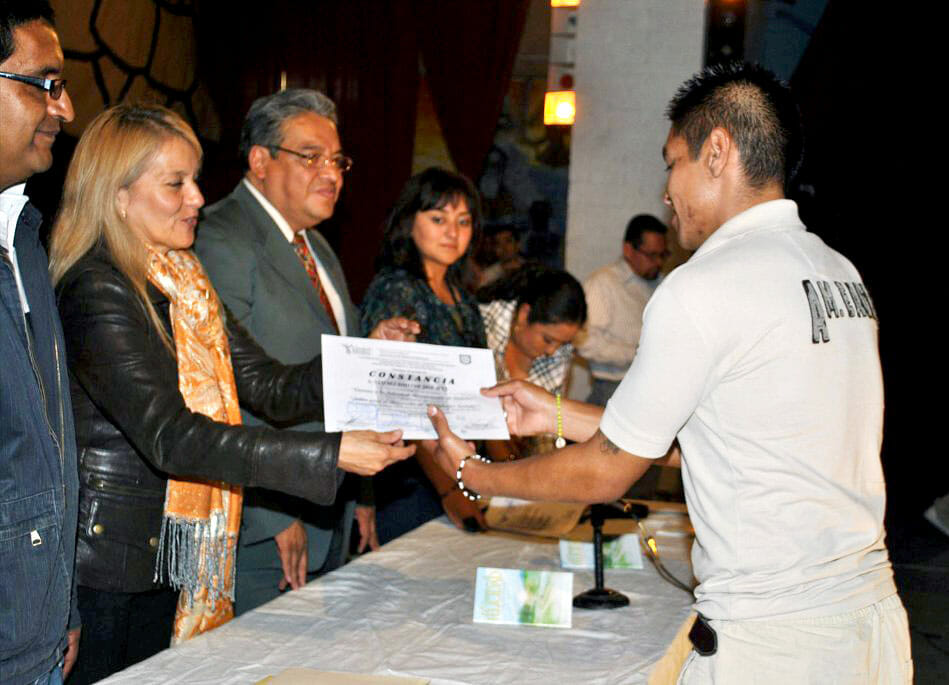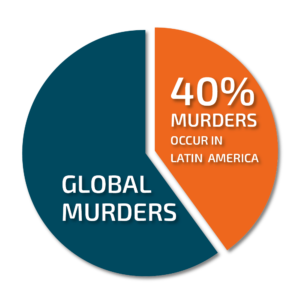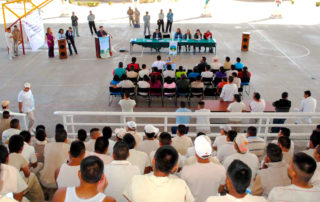
Latin America
Latin America has some of the highest crime rates in the world. Narco-trafficking fuels most of this crime, leaving untold destruction in its wake. Narco-trafficking leads to homicides, robberies, and assaults, reducing both the quality of life and the Human Development Index of many Latin American countries. (The Human Development Index (HDI) is a measure of achievement in areas of human development)
Statistics on Crime in Latin America

Though Latin America contains only nine percent of the global population, the region is responsible for about 40 percent of global murders. It is the only area of the world where the murder rate is increasing, not declining and countries that contain the main nodes of drug trafficking are the hardest hit. These areas are prone to trafficking and attendant crime when the governments and police forces are vulnerable to corruption and threats of violence by the cartels.
Here is a snapshot view at 14 capital cities in Latin America and their homicide rates:
- Caracas, Venezuela: 76 per 100,000
- Guatemala City, Guatemala: 42.5 per 100,000
- Tegucigalpa, Honduras: 41 per 100,000
- San Salvador, El Salvador: 35.3 per 100,000
- Port of Spain, Trinidad and Tobago: 24.5 per 100,000
- District of Panama, Panama: 18.5 per 100,000
- Mexico City, Mexico: 17.6 per 100,000
- Montevideo, Uruguay: 14.7 per 100,000
- Bogotá, Colombia: 14.3 per 100,000
- Brasilia, Brazil: 13.7 per 100,000
- San José, Costa Rica: 12.9 per 100,000
- Santo Domingo, Dominican Republic: 10.4 per 100,000
- Lima, Peru: 8 per 100,000
- Managua, Nicaragua: 6.6 per 100,000
To put these numbers into perspective, the global homicide rate is at 7.6 homicides per 100,000 population, per the Geneva Declaration on Armed Violence and Development. The majority of Latin American capital cities have homicide rates significantly higher than the international average.
Criminal Justice in Latin America
Several factors influence criminal justice in Latin America. From Carlos J. Vilalta’s Crime and Justice in Latin America, “What is typically known about crime and justice in Latin America is that the country has the highest rate of violence on the planet; it has undergone profound economic and political transformations, therefore many Latin American states are weak and lack institutional capacity to control crime, and its crime data systems are in their infancy.”
A combustible combination of departing colonial powers, extreme poverty, growing drug cartel presence, corruption in the police and political leadership, lack of infrastructure, and covert foreign intervention has created ongoing destabilization and crime in the region.
The full scope of influencing factors, related to crime in South America, can be understood by examining illicit drug consumption and human trafficking patterns across the planet.
The United States is the largest consumer of illicit drugs in the world and the proximity of the Latin American countries to the US facilitates demand fulfillment. Illicit drug use is rising in Europe and South American trans-shipment points have been established to fulfill that demand. Additionally, and tragically, some areas of South America are hubs for human trafficking. These issues are not only relevant to gaining insight into the overall picture of crime in Latin America – they are critical when considering remedies for crime and criminal justice.
Latin America is faced with the daunting task of developing a criminal justice system that addresses the complexities surrounding regional crime and its perpetuation by global influences. Again, to quote Vilalta, “It is true that crime and violence have been increasing throughout the 21st century in Latin America. It is also true that the police, the judiciary, and the prison system rarely perform well enough, at least in the majority of the countries in the region. In fact, their performance is way below what is expected.”
Punishment for Crimes Committed in Latin America
Punishments and penalties for crimes committed in Latin America have skyrocketed in recent decades. In a continuing (but failed) attempt to stem illicit drug related crime, drug offenders are often given longer sentences than murderers and rapists.
For example, in 1950, the average maximum sentence for a drug offense was 34 years in prison. In 2013, the average maximum penalty for a drug offense was 141 years in prison.
Though intended to curtail drug trafficking violence, these policies have only made it worse in many ways. When a vacancy in trafficking personnel is created through police intervention, other suppliers step up to fill the demand – and this can lead to more warfare amongst cartels. Meanwhile, low- level dealers and non-violent users languish in prison- often longer than murderers.
Quoting Addicted to Punishment: The Disproportionality of Drug Laws in Latin America, “When comparing murder with drug trafficking, the logical assumption is that penalties for murder must be higher because it results in a concrete harm to a very important protected legal right—human life and personal integrity—while trafficking does not, in and of itself, lead to such a harm.”
Conditions surrounding imprisonment are poor with unfair sentencing, overcrowding, poor prison conditions, lack of social reintegration post-release and inhumane treatment of prisoners.
Criminal Justice Reform in Latin America
It is evident that an exponential increase in penalties has been ineffective in curbing drug-related crime. Additionally, the inhumanity and unworkability of these policies has perpetuated fundamental human rights violations for victims and perpetrators.
Issues of criminal justice and prison reform in Latin America have grabbed international attention in recent years. Peoples’ movements and incipient democratic institutions are calling for the development of more fair and humane criminal justice programs across Latin America.
The United Nations Office on Drugs and Crime is working with Latin American judicial bodies to inculcate a mission towards reform within Latin American countries. The focus is to address the direct effects of imperfect criminal justice. Quoting the UNDODC, “Imprisonment disproportionately affects individuals and families living in poverty. It also burdens a country’s public health system, given that in many places prisoners are likely to be suffering from health problems which will not receive proper care inside prison. Additionally, imprisonment disrupts relationships and families, thus weakening social cohesion.”
Lasting reform will require policy changes, not only at the regional level, but on a global level as well. Demand reduction through education and legislation as well as tighter immigration policies in other areas of the world can strengthen attempts to improve the Latin American Justice system.
There is a growing interest among developed countries to improve the Latin American justice system. Hopefully, this interest will give rise to effective and coordinated global efforts substantial enough for real progress.
Sources:
- https://www.insightcrime.org/news/analysis/2019-homicides-latin-america-capital/
- http://www.genevadeclaration.org/fileadmin/docs/Global-Burden-of-Armed-Violence-full-report.pdf
- https://www.oxfordbibliographies.com/view/document/obo-9780195396607/obo-9780195396607-0172.xml
- https://www.opensocietyfoundations.org/publications/addicted-punishment-disproportionality-drug-laws-latin-america
- https://www.unodc.org/unodc/en/frontpage/2011/August/prison-reform-in-latin-america-and-the-caribbean.html
- http://hdr.undp.org/en/content/human-development-index-hdi



